Gneiss rock, a captivating metamorphic stone with its distinct banded appearance, has diverse applications in construction, landscaping, and design; at rockscapes.net, we help you discover the beauty and resilience of gneiss for your next project. From durable building materials to stunning landscaping features, explore how gneiss can elevate your space with natural elegance and unique stone patterns, and discover the possibilities of gneiss rock for your hardscaping and landscape design.
1. Understanding Gneiss Rock: Composition, Formation, and Characteristics
What exactly is gneiss rock, and what makes it so unique? Gneiss is a metamorphic rock, meaning it was formed from other types of rock that were transformed by intense heat and pressure.
1.1. How Does Gneiss Form?
Gneiss typically starts as sedimentary rocks like shale or sandstone, or igneous rocks like granite. During metamorphism, these rocks are subjected to temperatures exceeding 320 degrees Fahrenheit (160 degrees Celsius) and significant pressure. This process re-crystallizes the minerals, causing them to align in bands, which gives gneiss its characteristic foliated texture. According to Arizona State University’s School of Earth and Space Exploration, the exact mineral composition and the intensity of heat and pressure determine the final appearance and properties of the gneiss.
1.2. What Minerals Make Up Gneiss Rock?
The primary minerals in gneiss are feldspar, quartz, and mica, similar to granite. However, the metamorphic process causes these minerals to separate into distinct bands. Darker bands are rich in minerals like biotite mica, hornblende, and other ferromagnesian minerals (containing iron and magnesium). Lighter bands are predominantly quartz and feldspar. This mineral arrangement contributes to gneiss’s durability and unique aesthetic appeal.
1.3. What Are the Key Characteristics of Gneiss?
Gneiss boasts several key characteristics that make it a valuable material:
- Foliated Texture: The most distinguishing feature is its banded appearance, created by alternating layers of light and dark minerals.
- Durability: Gneiss is a hard, dense rock, making it resistant to weathering and erosion.
- Variety of Colors: Gneiss comes in a range of colors, including gray, pink, red, yellow, and white, depending on its mineral composition.
- High Compressive Strength: Its robust nature makes it suitable for load-bearing applications.
- Heat Resistance: Gneiss can withstand high temperatures, making it appropriate for fireplaces and outdoor fire pits.
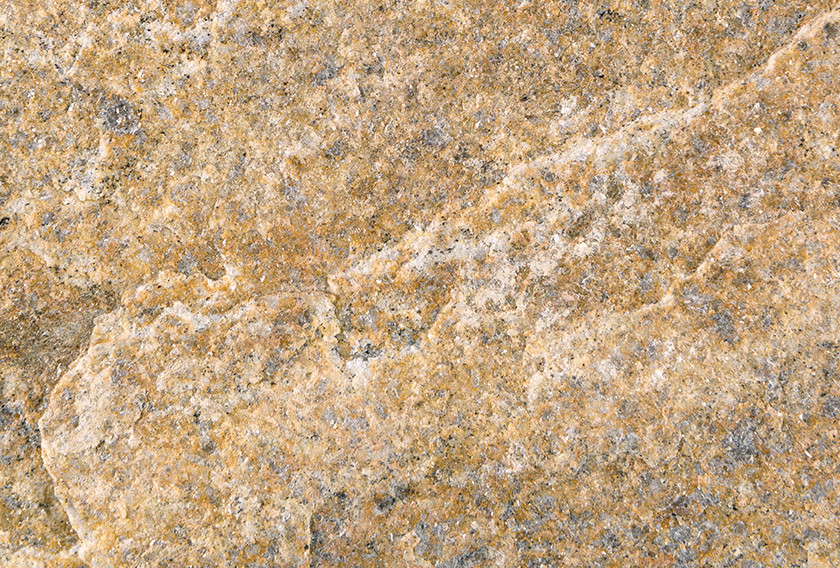 Banded texture of gneiss rock
Banded texture of gneiss rock
1.4. How Does Gneiss Compare to Granite?
While both gneiss and granite are hard, durable rocks used in construction, they differ in texture. Granite is an igneous rock with a granular, speckled appearance, whereas gneiss is metamorphic with a banded, layered look. This textural difference arises from their formation processes: granite cools slowly from molten rock, allowing crystals to form randomly, while gneiss undergoes intense pressure and heat, aligning minerals into bands.
2. What Are the Practical Uses of Gneiss Rock? Construction and Landscaping
How can you incorporate gneiss rock into your projects? Gneiss is a versatile material with a wide array of uses, from structural components in buildings to decorative elements in landscaping.
2.1. How is Gneiss Used in Building Construction?
Gneiss has been used as a building material for centuries, valued for its strength and aesthetic appeal. Here are some common applications:
- Foundation Stone: Its high compressive strength makes it an excellent choice for foundations, providing a stable base for structures.
- Exterior Cladding: Gneiss cladding provides a durable and visually appealing exterior for buildings, protecting them from the elements.
- Interior Flooring: Gneiss tiles are suitable for high-traffic areas due to their durability and resistance to wear.
- Countertops: Gneiss countertops offer a unique and robust surface for kitchens and bathrooms, with excellent heat resistance.
2.2. How Is Gneiss Used in Landscaping?
Gneiss can enhance the beauty and functionality of outdoor spaces in numerous ways:
- Retaining Walls: Gneiss boulders and blocks can be used to create sturdy and attractive retaining walls, preventing soil erosion and adding visual interest.
- Paving Stones: Gneiss paving stones are ideal for walkways, patios, and driveways, offering a durable and slip-resistant surface.
- Garden Edging: Gneiss can define garden beds and pathways, adding a natural and sophisticated touch to your landscape.
- Water Features: Gneiss rocks can be incorporated into water features like ponds and waterfalls, creating a natural and serene environment.
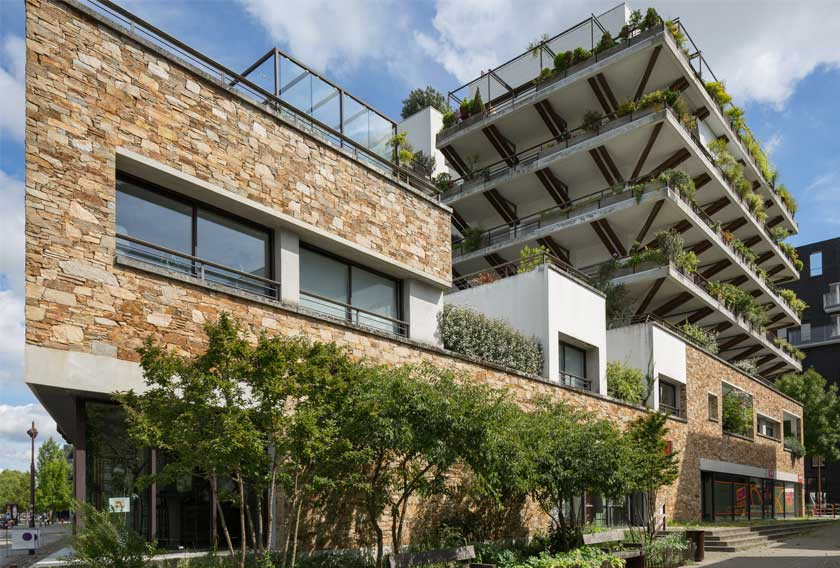 Saint-Yrieix gneiss blocks used for building facade
Saint-Yrieix gneiss blocks used for building facade
2.3. What Are Some Unique Applications of Gneiss?
Beyond traditional construction and landscaping, gneiss can be used in more creative and artistic ways:
- Sculptures: Artists can carve gneiss into stunning sculptures, highlighting its natural patterns and colors.
- Fireplaces: Gneiss is an excellent material for fireplace surrounds due to its heat resistance and visual appeal.
- Accent Walls: Gneiss can create striking accent walls, adding texture and depth to interior spaces.
- Furniture: Gneiss slabs can be used to create unique and durable tabletops, benches, and other furniture pieces.
2.4. Where Can You Find Gneiss Rock?
Gneiss is found in many parts of the world, often in areas with a history of tectonic activity and mountain building. Major deposits are located in:
- North America: The Appalachian Mountains and the Canadian Shield are rich in gneiss.
- Europe: Scotland, Scandinavia, and parts of France have significant gneiss deposits.
- Asia: Gneiss is found in the Himalayas and parts of China.
- Africa: Madagascar and parts of South Africa are known for their gneiss formations.
3. Advantages of Using Gneiss Rock
Why should you choose gneiss rock for your projects? Gneiss offers a range of benefits that make it a superior choice for various applications.
3.1. What Are the Durability Benefits of Gneiss?
Gneiss is known for its exceptional durability, making it a long-lasting material for both construction and landscaping. Its density and hardness allow it to withstand:
- Weathering: Gneiss resists the effects of rain, snow, and sun, maintaining its appearance over time.
- Erosion: Its compact structure prevents it from breaking down easily, even in harsh environments.
- Physical Impact: Gneiss can withstand heavy loads and impacts, making it suitable for high-traffic areas.
3.2. How Does Gneiss Offer Aesthetic Appeal?
Gneiss is not only durable but also visually appealing, adding a touch of natural elegance to any project. Its unique aesthetic qualities include:
- Unique Patterns: The banded patterns in gneiss create a distinctive and eye-catching look.
- Color Variations: With a range of colors available, gneiss can complement various design styles.
- Natural Texture: The natural texture of gneiss adds depth and character to surfaces.
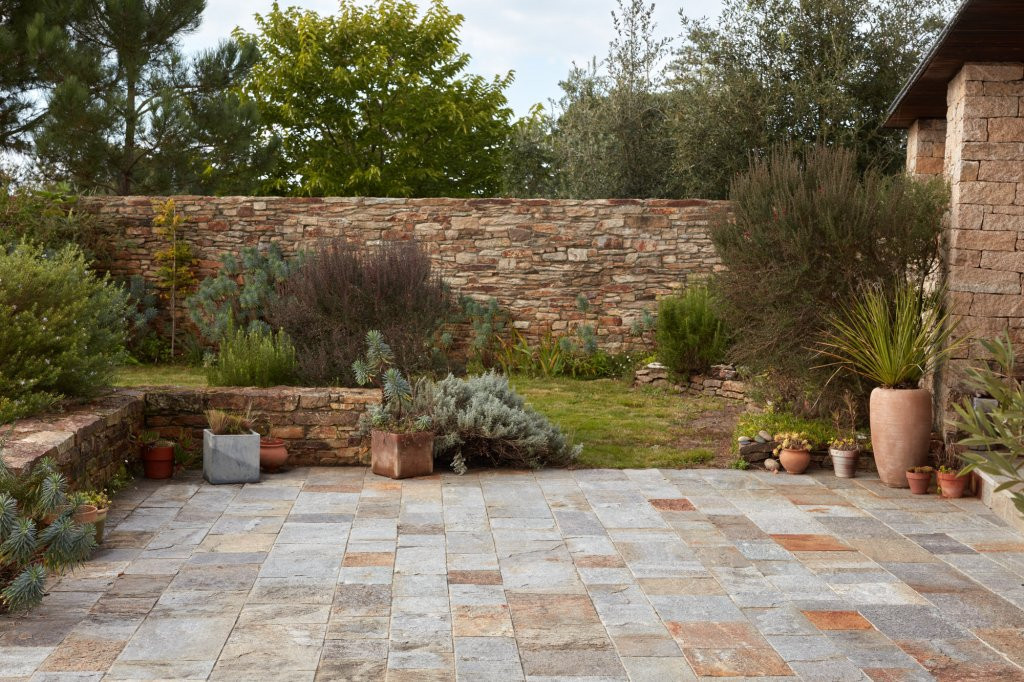 Gneiss paving with different tones
Gneiss paving with different tones
3.3. Is Gneiss Environmentally Friendly?
Using gneiss can be an environmentally responsible choice due to:
- Natural Material: Gneiss is a natural stone that requires minimal processing compared to manufactured materials.
- Longevity: Its durability means it doesn’t need to be replaced frequently, reducing waste.
- Local Sourcing: Sourcing gneiss locally can reduce transportation costs and emissions.
3.4. How Does Gneiss Compare in Cost to Other Stones?
The cost of gneiss can vary depending on factors such as:
- Quarry Location: The distance from the quarry to your project site can affect transportation costs.
- Stone Quality: Higher quality gneiss with unique patterns and colors may be more expensive.
- Processing: Cut and finished gneiss will generally cost more than raw, un обработанный stone.
Generally, gneiss is competitively priced compared to other natural stones like granite and marble, offering a balance of affordability and quality.
4. Designing with Gneiss Rock: Styles and Ideas
How can you creatively use gneiss in your designs? Gneiss complements various architectural and landscaping styles, adding a touch of natural beauty and sophistication.
4.1. How Does Gneiss Fit Into Modern Designs?
In modern designs, gneiss can be used to create clean, minimalist looks. Consider:
- Sleek Countertops: Gneiss countertops with a polished finish can add a touch of elegance to modern kitchens.
- Accent Walls: A gneiss accent wall can create a focal point in a living room or office, adding texture and visual interest.
- Outdoor Patios: Gneiss paving stones can be used to create modern, low-maintenance patios and walkways.
4.2. How Does Gneiss Rock Fit Into Rustic Designs?
Gneiss fits seamlessly into rustic designs, enhancing the natural and rugged aesthetic. Ideas include:
- Stone Fireplaces: A gneiss fireplace surround can create a cozy and inviting atmosphere in a rustic home.
- Retaining Walls: Gneiss retaining walls can add a natural and functional element to rustic landscapes.
- Garden Pathways: Gneiss pathways can meander through gardens, creating a charming and rustic feel.
4.3. How Can Gneiss Be Used in Garden and Landscape Design?
Gneiss can transform gardens and landscapes into stunning natural environments. Consider:
- Water Features: Incorporating gneiss rocks into ponds, streams, and waterfalls can create a serene and picturesque setting.
- Rock Gardens: Gneiss can be used to create beautiful rock gardens, showcasing its unique patterns and colors.
- Edging and Borders: Using gneiss to define garden beds and pathways can add a polished and natural look.
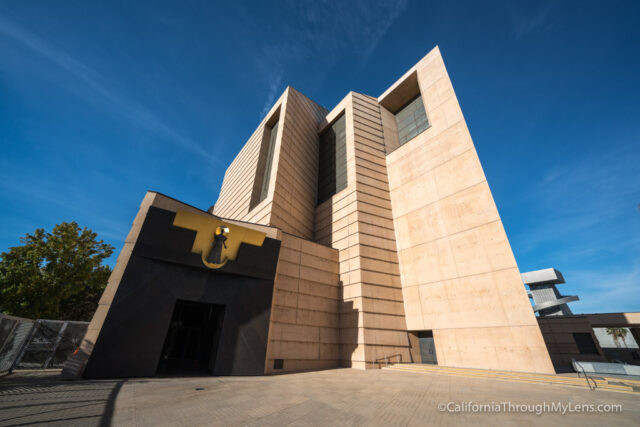 Gneiss at Los Angeles Cathedral
Gneiss at Los Angeles Cathedral
4.4. Where Can You Find Inspiration for Gneiss Designs?
Looking for inspiration? Explore these resources:
- Online Galleries: Websites like Pinterest and Houzz offer numerous images of gneiss applications in construction and landscaping.
- Magazines: Architectural and landscape design magazines often feature projects incorporating natural stone like gneiss.
- Local Showrooms: Visiting local stone yards and showrooms can provide hands-on inspiration and expert advice.
5. Maintaining Gneiss Rock: Cleaning and Preservation
How do you keep gneiss rock looking its best? Proper maintenance is essential to preserve the beauty and longevity of gneiss surfaces.
5.1. How Do You Clean Gneiss Surfaces?
Regular cleaning can prevent dirt and stains from accumulating on gneiss surfaces. Follow these tips:
- Regular Sweeping/Dusting: Use a soft broom or duster to remove loose dirt and debris.
- Mild Soap and Water: Clean surfaces with a mild soap and warm water solution.
- Non-Abrasive Cleaners: Avoid using harsh chemicals or abrasive cleaners that can damage the stone.
5.2. How Do You Prevent Stains on Gneiss?
Preventing stains is easier than removing them. Here are some preventive measures:
- Sealing: Apply a sealant to gneiss surfaces to protect them from absorbing liquids.
- Spill Cleanup: Clean up spills immediately to prevent them from setting in.
- Coasters and Mats: Use coasters under drinks and mats under dishes to protect surfaces from stains and scratches.
5.3. How Do You Repair Damaged Gneiss?
Even with proper care, gneiss can sometimes get damaged. Here’s how to address common issues:
- Chips and Cracks: Small chips and cracks can often be repaired with epoxy or stone fillers.
- Professional Repair: For significant damage, it’s best to hire a professional stone restoration service.
- Replacement: In some cases, the damaged section may need to be replaced entirely.
5.4. What Are Some Common Mistakes to Avoid When Caring for Gneiss?
Avoid these common mistakes to keep your gneiss in top condition:
- Using Acidic Cleaners: Acidic cleaners like vinegar or lemon juice can etch and damage gneiss.
- Abrasive Scrubbing: Avoid using abrasive pads or brushes that can scratch the surface.
- Ignoring Stains: Letting stains sit for extended periods can make them harder to remove.
6. Sourcing Gneiss Rock: Finding the Right Supplier
Where can you find high-quality gneiss for your projects? Choosing the right supplier is crucial to ensure you get the best materials.
6.1. What Should You Look for in a Gneiss Supplier?
Consider these factors when choosing a gneiss supplier:
- Reputation: Look for suppliers with a good reputation for quality and service.
- Selection: Choose a supplier that offers a wide variety of gneiss types and sizes.
- Experience: Opt for suppliers with experience in the stone industry, who can provide expert advice.
- Certifications: Check if the supplier has certifications for quality and sustainability.
6.2. How Do You Ensure Quality When Buying Gneiss?
Ensure you are getting high-quality gneiss by:
- Inspecting Samples: Examine samples closely for any cracks, flaws, or inconsistencies.
- Checking References: Ask the supplier for references and contact them to inquire about their experience.
- Requesting Test Data: Request test data on the stone’s durability, strength, and composition.
6.3. Can You Buy Gneiss Online?
Yes, many suppliers offer gneiss for sale online. However, it’s essential to:
- Read Reviews: Check online reviews and ratings of the supplier.
- Request Photos: Request detailed photos of the stone from multiple angles.
- Check Return Policies: Ensure the supplier has a clear and fair return policy.
6.4. What Are the Questions You Should Ask a Gneiss Supplier?
Ask these questions to ensure you are making an informed decision:
- What is the origin of the gneiss?
- What is the stone’s compressive strength and durability?
- Does the stone require sealing?
- What are the recommended cleaning and maintenance procedures?
- What is the lead time for delivery?
7. Gneiss Rock in Iconic Landmarks Around the World
What are some famous examples of gneiss in architecture? Gneiss has been used in numerous iconic landmarks, showcasing its beauty and durability.
7.1. How Was Gneiss Used in Grand Central Terminal in New York?
Grand Central Terminal in New York stands on a foundation of Manhattan gneiss, demonstrating the stone’s strength and stability in supporting a major structure.
7.2. How Was Gneiss Used in the Scottish Parliament Building?
The Scottish Parliament Building features Lewisian gneiss, one of the oldest rocks on Earth, adding geological depth and character to a modern civic icon.
7.3. How Was Gneiss Used in the Cathedral of Our Lady of the Angels in Los Angeles?
The Cathedral of Our Lady of the Angels in Los Angeles incorporates gneiss to bridge tradition and innovation in its architectural language.
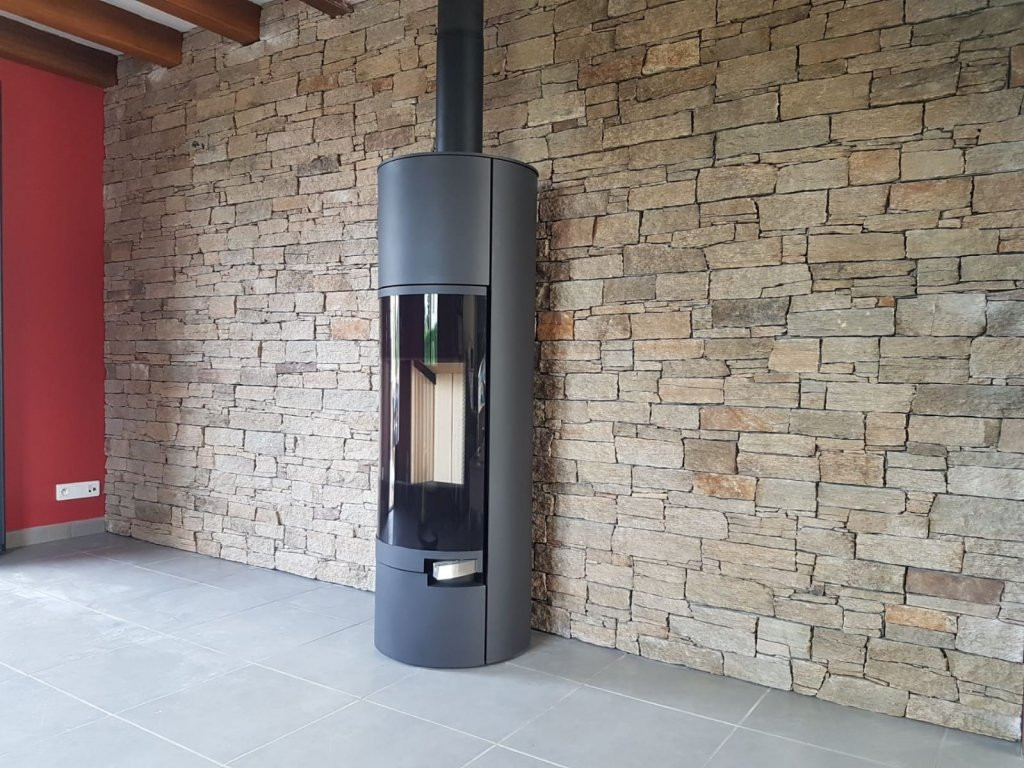 Gneiss natural stone cladding
Gneiss natural stone cladding
7.4. How Was Gneiss Used in the Mustang Broadcasting Community Radio Station in Nepal?
The Mustang Broadcasting Community Radio Station in Nepal uses locally sourced gneiss to mirror the rocky mountain landscape, blending architecture seamlessly into its environment.
8. The Future of Gneiss Rock: Trends and Innovations
What does the future hold for gneiss rock? Gneiss continues to evolve with new trends and innovations in construction and design.
8.1. What Are the Emerging Trends in Gneiss Use?
Emerging trends in gneiss use include:
- Thin Veneers: Thin gneiss veneers are becoming popular for interior and exterior cladding, offering a lightweight and cost-effective alternative to solid stone.
- Sustainable Design: Gneiss is increasingly being used in sustainable design projects due to its natural properties and longevity.
- Custom Designs: Advances in cutting and shaping technology are allowing for more custom and intricate gneiss designs.
8.2. How Are New Technologies Impacting Gneiss Applications?
New technologies are enhancing gneiss applications through:
- Precision Cutting: CNC (Computer Numerical Control) machines allow for precise cutting and shaping of gneiss, enabling complex designs.
- Advanced Sealing: New sealing technologies are improving the stain resistance and longevity of gneiss surfaces.
- 3D Printing: 3D printing technology is being explored for creating custom gneiss components and structures.
8.3. What Are the Sustainable Practices in Gneiss Quarrying?
Sustainable practices in gneiss quarrying include:
- Reclamation: Quarry operators are reclaiming mined areas by replanting vegetation and restoring habitats.
- Water Management: Water is being recycled and reused to minimize water consumption.
- Waste Reduction: Waste materials are being recycled and used in other construction applications.
8.4. How Is Gneiss Contributing to Green Building Initiatives?
Gneiss is contributing to green building initiatives by:
- Reducing Carbon Footprint: Its durability and longevity reduce the need for frequent replacements, lowering the carbon footprint of buildings.
- Conserving Resources: Gneiss is a natural material that requires minimal processing compared to manufactured materials.
- Improving Energy Efficiency: Gneiss can provide thermal mass, helping to regulate indoor temperatures and reduce energy consumption.
9. FAQ About Gneiss Rock Uses
Have more questions about gneiss? Here are some frequently asked questions:
9.1. Is Gneiss a Good Choice for Kitchen Countertops?
Yes, gneiss is an excellent choice for kitchen countertops due to its durability, heat resistance, and unique aesthetic appeal.
9.2. Can Gneiss Be Used for Outdoor Patios?
Yes, gneiss paving stones are ideal for outdoor patios, offering a durable and slip-resistant surface.
9.3. How Does Gneiss Compare to Slate?
Gneiss and slate are both metamorphic rocks, but they have different textures. Gneiss has a banded appearance, while slate has a layered, platy texture.
9.4. What Colors Does Gneiss Rock Come In?
Gneiss comes in a range of colors, including gray, pink, red, yellow, and white, depending on its mineral composition.
9.5. Is Gneiss a Hard or Soft Stone?
Gneiss is a hard stone, making it resistant to scratches and wear.
9.6. Can You Seal Gneiss to Protect It From Stains?
Yes, sealing gneiss is recommended to protect it from stains and moisture.
9.7. How Do You Remove Stains From Gneiss?
Remove stains from gneiss with a mild soap and water solution or a specialized stone cleaner. Avoid using acidic or abrasive cleaners.
9.8. Is Gneiss Suitable for Fireplace Surrounds?
Yes, gneiss is suitable for fireplace surrounds due to its heat resistance and attractive appearance.
9.9. Where Can I Find Gneiss Rock Near Me?
Find gneiss rock near you by searching online directories, contacting local stone yards, or visiting home improvement stores.
9.10. How Much Does Gneiss Rock Cost?
The cost of gneiss rock varies depending on the quality, size, and location, but it is generally competitively priced compared to other natural stones.
10. Transform Your Space with Gneiss Rock from Rockscapes.net
Ready to elevate your space with the timeless beauty and durability of gneiss rock? At rockscapes.net, we offer a wide selection of gneiss in various colors, patterns, and sizes to suit your unique design needs. Whether you’re looking to create a stunning kitchen countertop, a durable outdoor patio, or a captivating garden landscape, gneiss is the perfect choice.
Explore our extensive collection of gneiss and other natural stones at rockscapes.net. Get inspired by our design ideas, learn about the different types of stone, and get expert advice on installation and maintenance. Let Rockscapes.net help you transform your vision into reality.
Address: 1151 S Forest Ave, Tempe, AZ 85281, United States
Phone: +1 (480) 965-9011
Website: rockscapes.net
Visit rockscapes.net today and discover the endless possibilities of gneiss rock!
